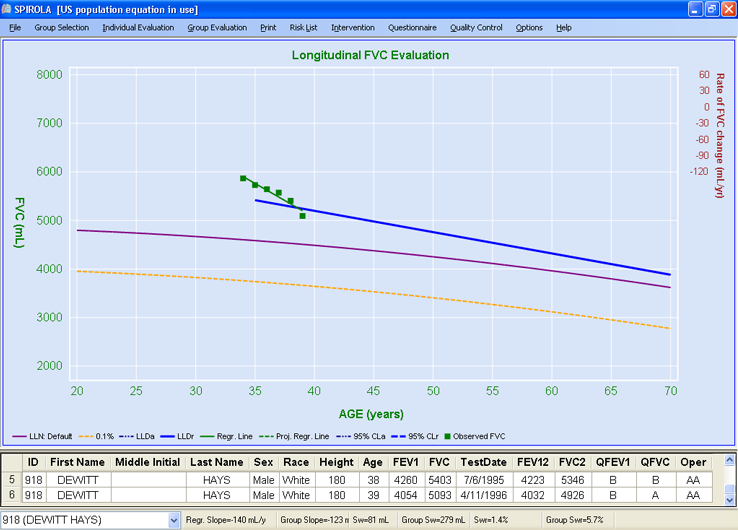SPIROMETRY
Spirometry Monitoring Technology

Longitudinal FVC values (green dots) plotted against age and evaluated against the cross-sectional limits: lower limit of normal (purple line) and 0.1th percentile (≈60% predicted, orange line)
Spirometry monitoring can be used in the primary, secondary, and tertiary prevention of occupational and non-occupational respiratory disease and in the maintenance of workers’ fitness. Primary prevention of occupational respiratory disease through control or elimination of adverse exposures in the workplace is a priority. With respect to primary prevention, spirometry monitoring of workers can be used to assess the respiratory health status of subgroups of workers exposed to a particular agent (or production process) to determine if exposures to that agent (or production process) is unsafe and needs to be controlled. However, even with exposure controls in place, some workers may be adversely affected; such residual occupational risks and non-occupational exposures (e.g., tobacco smoke) provide a role for spirometry monitoring in secondary and tertiary prevention. With respect to secondary prevention, spirometry can be used to monitor worker populations exposed to potential respiratory hazards to identify otherwise healthy individuals who are experiencing excessive lung function decline; individualized preventive intervention can then be applied to prevent further excessive loss and subsequent lung function impairment. With respect to tertiary prevention, spirometry can be used to carefully monitor an individual worker with established lung function impairment and/or symptoms as part of clinical management to help prevent disabling impairment and limit symptoms. Generally, respiratory disease prevention is best done as part of an overall health maintenance program in which results of spirometry evaluations are linked with exposure control, smoking cessation, and general health-promotion interventions.
To achieve the above objectives, it is important to:
- maintain acceptable quality of the spirometry data;
- apply an interpretative strategy that has a high likelihood of promptly identifying individuals with excessive loss of lung function who are at increased risk of developing disabling lung function impairment;
- couple results of health monitoring to effective group and individual intervention strategies.
Spirometry Longitudinal Data Analysis (SPIROLA) Software
SPIROLA software is an easy-to-use visual and quantitative tool intended to assist the health care provider in monitoring and interpreting computerized longitudinal spirometry data for individuals as well as groups. It can be used for primary, secondary, and tertiary prevention (see above).
- Page last reviewed: December 14, 2012
- Page last updated: October 30, 2015
- Content source:
- National Institute for Occupational Safety and Health Respiratory Health Division


 ShareCompartir
ShareCompartir